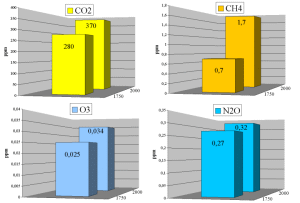|
|
 |
|
|
|
 |
| |
|
|
 |
How are
people changing
the climate?
Read more |
1. Man-made climate change?
Observed changes in concentrations of greenhouse gases in the atmosphere
|
|
|
|
|
 |
- Carbon dioxide (CO2) has increased from 280 ppm (that is, liters CO2 per million liters of air) in the period 1000-1750 to about 370 ppm today. This is about a 31% increase, and today’s levels are the highest concentration of CO2 in the atmosphere in at least 420,000 years, probably 20 million years.
- Methane (CH4) has increased from 0.7 ppm in 1750 to 1.7 ppm in 2000. This is an increase of about 151%.
|
 |
 |
 |
|
1. INCREASED CONSENTRATIONS of greenhouse gases in ppm from 1750 to 2000. Graphics: Elmar Uherek (click to enlarge, 35 kB)
|
|
- Nitrous oxide (N2O) has increased from 0.27 ppm in 1750 to 0.32 ppm in 2000. This is about a 17% increase.
- Tropospheric ozone (O3) – that is, ozone that forms in the lower atmosphere below the ozone layer – has increased by about 35% from 1750 to 2000, but this figure varies from region to region. In addition to shielding the Earth from ultraviolet radiation, ozone is also a greenhouse gas. Ozone is formed and broken down by chemical reactions in the atmosphere, and humans emit other substances that influence these chemical reactions.
(Source: IPCC 2001 and http://cdiac.esd.ornl.gov/pns/current_ghg.html).
|
|
Author: Camilla Schreiner - CICERO (Center for International Climate and Environmental Research - Oslo) - Norway. Scientific reviewers: Andreas Tjernshaugen - CICERO (Center for International Climate and Environmental Research - Oslo) - Norway - 2004-01-20 and Knut Alfsen - Statistics Norway - Norway - 2003-09-12. Educational reviewer: Nina Arnesen - Marienlyst school in Oslo - Norway - 2004-03-10. Last update: 2004-03-27. |
|
 |
|









